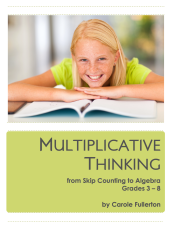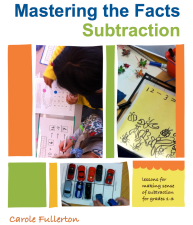Maintenant disponible en français!
Finally … French translations of my latest books are now available!
Je viens de traduire mes deux ressources de bonnes questions — “A Year of Good Questions for Grades 2-4” et “A Year of Good Questions for grades 5-8” — afin que mes collègues d’immersion aient des ressources françaises avec lesquelles travailler. Merci pour vôtre patience!
In these new French translations of the English originals, you’ll find more than 200 open-ended and engaging problems for french immersion students from primary through middle school. All are posed in French and explore important mathematical concepts across the grades.
 The first book: Bonnes Questions: Une année de bonnes tâches mathématiques pour les élèves de 2e à 4e is suitable for late primary students (grades 2-4) and features operational tasks, measurement tasks and pattern tasks of increasing complexity, posed in French.
The first book: Bonnes Questions: Une année de bonnes tâches mathématiques pour les élèves de 2e à 4e is suitable for late primary students (grades 2-4) and features operational tasks, measurement tasks and pattern tasks of increasing complexity, posed in French.
 The second volume: Bonnes Questions: Une année de bonnes tâches mathématiques pour les élèves de 5e à 8e is perfect for middle school immersion students (grades 5-8), with a focus on proportional reasoning, algebraic thinking as well as operations on integers, fractions and decimals to name a few.
The second volume: Bonnes Questions: Une année de bonnes tâches mathématiques pour les élèves de 5e à 8e is perfect for middle school immersion students (grades 5-8), with a focus on proportional reasoning, algebraic thinking as well as operations on integers, fractions and decimals to name a few.
Engaging problems and choice make these volumes the perfect conversation starter for our immersion classrooms, promoting oral language development and mathematical thinking …en même temps!
All are available from my online store.
Carole
New For Primary! Good Questions: A Year of Open-Ended Problems for Grades 2-4
For those of you who have been waiting ever so  patiently, I wanted to let you know that I have completed a primary companion to the Year of Good Questions for Grades 5-8 resource released this summer.
patiently, I wanted to let you know that I have completed a primary companion to the Year of Good Questions for Grades 5-8 resource released this summer.
A Year of Good Questions for Grades 2-4 is the late primary version of this stand up calendar of problems — one for every day of the school year!
Like its intermediate counterpart, this compact but potent book comes with an easel so you can set it up on your desk and flip from one rich problem to the next, posing open-ended questions of your primary students.

Good Questions: A Year of Open-Ended Math Problems for Grades 2-4 is a problem-a-day resource that includes rich tasks ideal for grades 2, 3 and 4. Organized by topic and structured in problem sets of 5, this simple to use teacher resource includes 200 mathematically important questions to engage your students in deep thinking. For only $25, it’s a reasonably priced way to stimulate and promote mathematical conversation!
Operations, measurement, proportional thinking and patterns are featured in this calendar of problems. Each one engages students in thinking flexibly, critically and creatively to solve tasks of varying complexity.
Visit my online store at mindfull.ecwid.com to order.
Let the fun begin!
Carole
Good Questions: A Year of Open-Ended Problems for Grades 5-8
I am pleased to say that — beyond spending every day on the water this summer — I DID manage to create a new teacher resource for my intermediate colleagues.
This time, it’s a stand up calendar of problems — one for every day of the school year!
This compact but potent book comes with an easel so you can set it up on your desk and flip from one rich problem to the next, posing open-ended questions of your intermediate students.

Good Questions: A Year of Open-Ended Tasks is a problem-a-day resource that includes
rich tasks ideal for grades 5, 6, 7 and 8. Organized by topic and structured in problem sets of 5 or more, this simple to use teacher resource includes 210 mathematically important questions to engage your students in deep thinking. For only $25, it’s a perfect back-to-school gift for yourself!
Proportional reasoning, measurement, operations and algebra are featured in this calendar of problems. Each one engages students in thinking flexibly, critically and creatively in the face of important and challenging mathematics.
Visit my online store at mindfull.ecwid.com to order.
Let the problem-solving begin!
Carole
Explaining the derivation of the Area of a Circle – Grade 7
So… we all know that the formula of the area of a circle is  .
.
But have you ever considered why? Students in Grade 7 need to understand the derivation of this formula and apply it to different situations. My husband sent me these awesome on-line demonstrations of how the area of s circle is derived, using what we know about triangles. Consider these images and what they show. First, the circle is chopped up into roughly triangular segments.

They are put together to form a parallelogram, in which the base is 1/2 of the circumference of the original circle.

The height of the parallelogram is the same as the radius of the circle (since each of the triangles is a section of the original circle).
To find the area of the parallelogram, we multiply the base times the height, or 1/2 of the circumference of the circle x the radius of the circle. Consider it in this more abstract language:
1/2 (  ) r which simplifies to
) r which simplifies to 
Cool, huh?
It’s WAY more effective to watch the video of the event. Check it out here!
Carole
PS – There’s another derivation that draws on the area of a triangle… I won’t wreck it for you, but consider this… The base of the large triangle here is the whole circumference of the circle, or 2πr. Each of the little triangles that make it has a height the same as the radius of the original circle. So that means that the area of this large circle is 1/2 base x height, or 1/2 (2πr) x radius/ Familiar?











